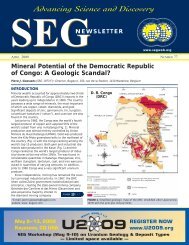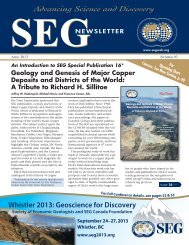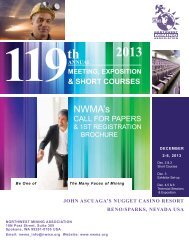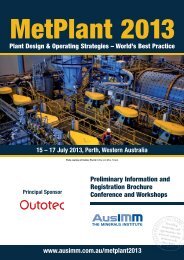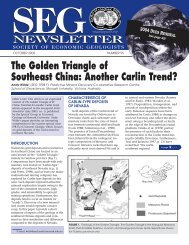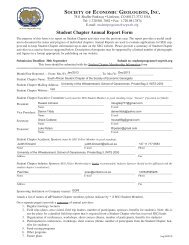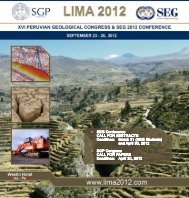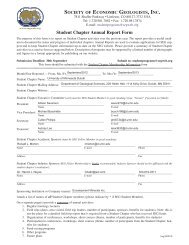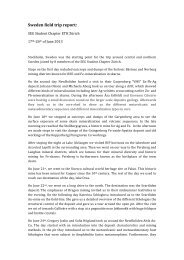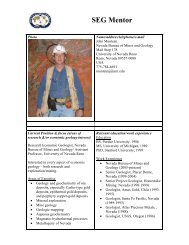SEG - Society of Economic Geologists
SEG - Society of Economic Geologists
SEG - Society of Economic Geologists
Create successful ePaper yourself
Turn your PDF publications into a flip-book with our unique Google optimized e-Paper software.
JULY 2012 • No 90 <strong>SEG</strong> NEWSLETTER 39<br />
Dalhousie University Student Chapter <br />
Field Trip to the PotashCorp<br />
and Xstrata Mines<br />
On February 2, five students from the<br />
Dalhousie University <strong>SEG</strong> student chapter<br />
embarked on a two-day trip from<br />
Halifax, Nova Scotia, to visit the Potash<br />
Corp potash mine in Sussex, NB, followed<br />
by a visit to the Pb-Zn mine outside<br />
Bathurst, NB. The trip was undertaken<br />
in conjunction with a group <strong>of</strong> 15<br />
engineering students and two instructors<br />
from the Mineral and Resource Engineer -<br />
ing Department at DAL; this is a yearly<br />
trip for the engineering students and we<br />
were very pleased to be invited along.<br />
While much <strong>of</strong> trip was geared more<br />
toward the engineering aspects <strong>of</strong> mining,<br />
both mines had geologists on staff.<br />
Our trip began at 3 a.m. in order to<br />
time our arrival at Sussex with a shift <strong>of</strong><br />
workers going down the mine shaft. The<br />
entire group was allowed underground<br />
A group <strong>of</strong> students, geologists, and engineers<br />
pose underground at PotashCorp in Sussex,<br />
NB.<br />
in a single shift and were taken on a<br />
guided truck tour <strong>of</strong> the different areas<br />
<strong>of</strong> the mine, where we were allowed to<br />
leave the vehicles and explore a bit.<br />
The following morning we again had<br />
an early start at the Xstrata-owned<br />
Brunswick mine, arriving at 7 a.m. to<br />
coincide with a scheduled shift change.<br />
The mine is currently in a winding-down<br />
phase with plans to cease major operations<br />
in early 2013 after 49 years <strong>of</strong> production<br />
in one <strong>of</strong> the largest underground<br />
mining operations in the world.<br />
We thank the <strong>SEG</strong> and the DAL Earth<br />
Sciences department who provided us<br />
with significant funding in order to<br />
undertake this. We also thank Dr. Don<br />
Jones and Dr. John Hill, from the DAL<br />
Mineral and Resource Engineering department,<br />
the leaders <strong>of</strong> the trip, for planning<br />
and coordinating trip activities, as<br />
well as the engineering students who<br />
attended. Finally, we thank PotashCorp<br />
and Xstrata for arranging these guided<br />
tours and allowing us to visit. 1<br />
Contributed by Kyle Landry<br />
<strong>SEG</strong><br />
www.segweb.org<br />
STUDENT NEWS<br />
The University <strong>of</strong> Nevada, Reno Student Chapter <br />
Field Trip to Turkey<br />
The University <strong>of</strong> Nevada, Reno student<br />
chapter recently completed an 11-day<br />
field trip through western Turkey. The<br />
focus <strong>of</strong> the trip was on exploring a relatively<br />
new and diverse metallogenic<br />
province that before the early 1990s<br />
was not open to foreign companies. We<br />
visited three producing mines and two<br />
exploration projects with a variety <strong>of</strong><br />
deposit types that included porphyry<br />
Cu-Au, porphyry Au, and epithermal<br />
Au-Ag. We also visited several historic<br />
sites, including the ancient city <strong>of</strong> Troy<br />
and the Roman ruins at Pergamon.<br />
After flying to Istanbul and enjoying<br />
a day <strong>of</strong> sightseeing the group took a<br />
ferry across the Sea <strong>of</strong> Marmara to the<br />
town <strong>of</strong> Bandirma, and then drove west<br />
to Çanakkale, on the banks <strong>of</strong> the Dar -<br />
danelles. The next morning we headed<br />
southeast toward Teck Resources’ Halilağa<br />
porphyry Cu-Au exploration project. We<br />
were greeted by the staff and taken to<br />
several outcrops to look at the leached<br />
capping <strong>of</strong> the porphyry system. When<br />
we returned the staff had laid out four<br />
complete drill holes so that we could<br />
see the classic porphyry alteration zoning<br />
and mineralization <strong>of</strong> the deposit.<br />
Our next stop was down the coast <strong>of</strong><br />
the Aegean to Bergama. After the standard<br />
Turkish breakfast <strong>of</strong> olives, salami,<br />
yogurt, and bread, we headed just outside<br />
<strong>of</strong> town to the Ovacık gold mine.<br />
Field trip participants tour Kişladağ, Tüprag’s porphyry-Au system in Uşak, Turkey.<br />
Ovacık is a low-sulfidation epithermal<br />
system and was the first gold mine in<br />
the region to be discovered by modern<br />
exploration techniques. After leaving<br />
Ovacık we headed back into Bergama to<br />
visit the Roman ruins at Pergamon.<br />
Next, we headed <strong>of</strong>f to the Efemçukuru<br />
low-sulfidation epithermal deposit<br />
owned by the Turkish subsidiary <strong>of</strong><br />
Eldorado Gold, Tüprag. Our next tour<br />
was the Au porphyry system Kişladağ,<br />
which is located about 1 hour southwest<br />
<strong>of</strong> the town <strong>of</strong> Uşak. Also owned<br />
by Tüprag, Kişladağ is the largest gold<br />
mine in Turkey, with an annual production<br />
<strong>of</strong> ~250,000 oz. Mineralization<br />
is hosted within a set <strong>of</strong> four nested<br />
alkali porphyritic intrusions that cut a<br />
series <strong>of</strong> quartz latite lava flows and volcaniclastics.<br />
Next, we drove northeast<br />
toward the Akarca project, a low-sulfidation<br />
epithermal system owned by<br />
Eurasian Minerals and Centera Gold.<br />
The deposit is located within Miocene<br />
to Pliocene basin sediments which overlie<br />
Paleozoic schists, limestones, and<br />
Paleocene granites.<br />
We thank our sponsors and industry<br />
participants who covered the student<br />
costs and made it possible for us to go<br />
on this amazing trip. 1<br />
Contributed by Tyler Baril



